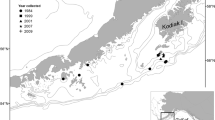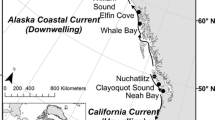Abstract
Annual growth patterns in the hard parts of marine organisms are often related to factors in the physical environment; investigators are increasingly borrowing methods from the field of dendrochronology (tree-ring science) to explore these relationships. When applied to otoliths of yellowfin sole Limanda aspera, an abundant and commercially important flatfish, this approach has demonstrated a strong positive correlation between otolith growth and bottom temperature in the southeastern Bering Sea. In the present study, we assess whether the biochronology–growth relationship extends to yellowfin sole collected at higher latitudes. Two new northern Bering Sea biochronologies, one from the Bering Strait region and one near St. Matthew Island, were developed and compared with the southeastern Bering Sea biochronology using mixed effects modeling. Despite large distances (up to 600 km), a high degree of synchrony was observed among all three chronologies. However, subtle differences in growth among the three regions were revealed upon closer examination. The relative amplitude of otolith growth differed among the three chronologies, with stronger negative anomalies in the south and stronger positive anomalies in the north. Differences in average length at age were also detected, with fish growing slower to greater lengths at higher latitudes. Lastly, the Bering Strait biochronology had the weakest and most localized relationships with climate variables, suggesting effects of climate may not be felt uniformly across the regions examined. Biochronologies may thus provide a useful tool in evaluating potential biological responses to projected climate change across a species’ range.





Similar content being viewed by others
Notes
Reference to trade names does not imply endorsement by the National Marine Fisheries Service, NOAA.
References
Bakkala RG (1981) Population characteristics and ecology of yellowfin sole. In: Hood DW, Calder JA (eds) The eastern Bering Sea shelf: oceanography and resources. US Dept Commer NOAA, Washington, DC, pp 553–574
Black BA (2009) Climate-driven synchrony across tree, bivalve, and rockfish growth-increment chronologies of the northeast Pacific. Mar Ecol Prog Ser 378:37–46. doi:10.3354/meps07854
Black BA, Boehlert GW, Yoklavich MM (2005) Using tree-ring crossdating techniques to validate annual growth increments in long-lived fishes. Can J Fish Aquat Sci 65:2277–2284. doi:10.1139/F05-142
Black BA, Schroeder ID, Sydeman WJ, Bograd SJ, Wells BK, Schwing FB (2011) Winter and summer upwelling modes and their biological importance in the California Current ecosystem. Global Change Biol 17:2536–2545. doi:10.1111/j.1365-2486.2011.02422.x
Black BA, Matta ME, Helser TE, Wilderbuer TK (2013) Otolith biochronologies as multidecadal indicators of body size anomalies in yellowfin sole (Limanda aspera). Fish Oceanogr 22(6):523–532. doi:10.1111/fog.12036
Black BA, Sydeman WJ, Frank DC, Griffin D, Stahle DW, García-Reyes M, Rykaczewski RR, Bograd SJ, Peterson WT (2014) Six centuries of variability and extremes in a coupled marine-terrestrial ecosystem. Science 345:1498–1502. doi:10.1126/science.1253209
Briffa KR, Melvin TM (2011) A closer look at regional curve standardization of tree-ring records: justification of the need, a warning of some pitfalls, and suggested improvements in its application. In: Hughes MK, Diaz HF, Swetnam TW (eds) Dendroclimatology: developments in paleoenvironmental research, vol 11, pp 553–574
Burnham KP, Anderson DR (2002) Model selection and multimodel inference: a practical information-theoretic approach, 2nd edn. Springer, New York
Butler PG, Richardson CA, Scourse JD, Wanamaker AD Jr, Shammon TM, Bennell JD (2010) Marine climate in the Irish Sea: analysis of a 489-year marine master chronology derived from growth increments in the shell of the clam Arctica islandica. Quat Sci Rev 29:1614–1632. doi:10.1016/j.quascirev.2009.07.010
Carilli JE, Norris RD, Black B, Walsh SM, McField M (2010) Century-scale records of coral growth rates indicate that local stressors reduce coral thermal tolerance threshold. Global Change Biol 16:1247–1257. doi:10.1111/j.1365-2486.2009.02043.x
Cook ER, Briffa KR, Meko DM, Graybill DA, Funkhouser G (1995) The ‘segment length curse’ in long tree-ring chronology development for palaeoclimatic studies. Holocene 5(2):229–237. doi:10.1177/095968369500500211
Fritts HC (1976) Tree rings and climate. Academic Press, New York
Gillanders BM, Black BA, Meekan MG, Morrison MA (2012) Climatic effects on the growth of a temperate reef fish from the Southern Hemisphere: a biochronological approach. Mar Biol 159:1327–1333. doi:10.1007/s00227-012-1913-x
Grant WS, Bakkala R, Utter FM, Teel DJ, Kobayashi T (1983) Biochemical genetic population structure of yellowfin sole, Limanda aspera, of the North Pacific Ocean and Bering Sea. Fish Bull 81(4):667–677. http://fishbull.noaa.gov/81-4/grant.pdf
Grebmeier JM, Smith Jr WO, Conover RJ (1995) Biological processes on Arctic continental shelves: ice-ocean-biotic interactions. In: Smith WO, Grebmeier JM (eds) Arctic oceanography: marginal ice zones and continental shelves. Coastal and Estuarine Studies 49, Washington DC, American Geophysical Union, pp 231–261
Grissino-Mayer HD (2001) Evaluating crossdating accuracy: a manual and tutorial for the computer program COFECHA. Tree Ring Res 57:205–221
Helama S, Schöne BR, Black BA, Dunca E (2006) Constructing long-term proxy series for aquatic environments with absolute dating control using a sclerochronological approach: introduction and advanced applications. Mar Freshw Res 57:591–599. doi:10.1071/MF05176
Helama S, Nielsen JK, Macias Fauria M, Valovirta I (2009) A fistful of shells: amplifying sclerochronological and palaeoclimate signals from molluscan death assemblages. Geol Mag 146:917–930. doi:10.1017/S0016756809990033
Helser TE, Lai H-L (2004) A Bayesian hierarchical meta-analysis of fish growth: with an example for North American largemouth bass, Micropterus salmoides. Ecol Model 178:399–416. doi:10.1016/j.ecolmodel.2004.02.013
Helser TE, Lai H-L, Black BA (2012) Bayesian hierarchical modeling of Pacific geoduck growth increment data and climate indices. Ecol Model 247:210–220. doi:10.1016/j.ecolmodel.2012.08.024
Hollowed AB, Planque B, Loeng H (2013) Potential movement of fish and shellfish stocks from the sub-Arctic to the Arctic Ocean. Fish Oceanogr 22:355–370. doi:10.1111/fog.12027
Holmes RL (1983) Computer-assisted quality control in tree-ring dating and measurement. Tree Ring Bull 43:69–78
IPCC (2014) Climate change 2014: synthesis report. Contribution of Working Groups I, II and III to the fifth assessment report of the Intergovernmental Panel on Climate Change [Core Writing Team, Pachauri RK, Meyers LA (eds)]. IPCC, Geneva, Switzerland. http://www.ipcc.ch
Kimura DK, Anderl DM, Goetz BJ (2007) Seasonal marginal growth on otoliths of seven Alaska groundfish species support the existence of annual patterns. Alaska Fish Res Bull 12(2):243–251. http://www.sf.adfg.state.ak.us/FedAidPDFs/AFRB.12.2.243-251.pdf
Lauth RR (2011) Results of the 2010 eastern and northern Bering Sea continental shelf bottom trawl survey of groundfish and invertebrate fauna. NOAA Tech Memo NMFS-AFSC-227. http://www.afsc.noaa.gov/Publications/AFSC-TM/NOAA-TM-AFSC-227.pdf
Matta ME, Goetz BJ (2012) Otolith growth pattern interpretation. In: Matta ME, Kimura DK (eds) Age determination manual of the Alaska Fisheries Science Center Age and Growth Program. NOAA Professional Paper NMFS 13, pp 5–10. http://spo.nwr.noaa.gov/pp13.pdf
Matta ME, Black BA, Wilderbuer TK (2010) Climate-driven synchrony in otolith growth-increment chronologies for three Bering Sea flatfish species. Mar Ecol Prog Ser 413:137–145. doi:10.3354/meps08689
Morrongiello JR, Thresher RE (2015) A statistical framework to explore ontogenetic growth variation among individuals and populations: a marine fish example. Ecol Monogr 85(1):93–115. doi:10.1890/13-2355.1
Morrongiello JR, Thresher RE, Smith DC (2012) Aquatic biochronologies and climate change. Nat Clim Change 2:849–857. doi:10.1038/nclimate1616
Nichol DG (1997) Effects of geography and bathymetry on growth and maturity of yellowfin sole, Pleuronectes asper, in the eastern Bering Sea. Fish Bull 95:494–503
NOAA (2014) Bering Sea climate. http://www.beringclimate.noaa.gov. Accessed 8 May 2014
Overland JE, Wang M (2013) When will the summer Arctic be nearly sea ice free? Geophys Res Lett 40:1–5. doi:10.1002/grl.50316
Rayner NE, Parker DE, Horton EB, Folland CK, Alexander LV, Rowell DP (2003) Global analyses of sea surface temperature, sea ice, and night marine air temperature since the late nineteenth century. J Geophys Res. doi:10.1029/2002JD002670
Shockley W, Matta ME (2012) Yellowfin sole (Limanda aspera). In: Matta ME, Kimura DK (eds) Age determination manual of the Alaska Fisheries Science Center Age and Growth Program. NOAA Professional Paper NMFS 13, pp 77–84. http://spo.nwr.noaa.gov/pp13.pdf
Stabeno PJ, Farley Jr Ed, Kachel NB, Moore S, Mordy CW, Napp JM, Overland JE, Pinchuk AI, Sigler MF (2012) A comparison of the physics of the northern and southern shelves of the eastern Bering Sea and some implications for the ecosystem. Deep Sea Res II 65–70:14–30. doi:10.1016/j.dsr2.2012.02.019
von Bertalanffy L (1938) A quantitative theory of organic growth (inquiries on growth laws II). Hum Biol 10(2):181–213
von Biela VR, Kruse GH, Mueter FJ, Black BA, Douglas DC, Helser TE, Zimmerman CE (2015) Evidence of bottom-up limitations in nearshore marine systems based on otolith proxies of fish growth. Mar Biol 162:1019–1031. doi:10.1007/s00227-015-2645-5
Wakabayashi K (1989) Studies on the fishery biology of yellowfin sole in the eastern Bering Sea [in Japanese, English summary]. Bull Far Seas Fish Res Lab 26:21–152
Weisberg S, Spangler G, Richmond LS (2010) Mixed effects models for fish growth. Can J Fish Aquat Sci 67:269–277. doi:10.1139/F09-181
Wilderbuer TK, Walters GE, Bakkala RG (1992) Yellowfin sole, Pleuronectes asper, of the eastern Bering Sea: biological characteristics, history of exploitation, and management. Mar Fish Rev 54(4):1–18. http://spo.nmfs.noaa.gov/mfr544/mfr5441.pdf
Wilderbuer TK, Nichol DG, Ianelli J (2015) Assessment of the yellowfin sole stock in the Bering Sea and Aleutian Islands. In: Stock assessment and fishery evaluation report for the groundfish resources of the Bering Sea/Aleutian Islands regions. Compiled by the Plan Team for the Groundfish Fisheries of the Bering Sea and Aleutian Islands, North Pacific Fishery Management Council, Anchorage, AK, pp 733–820. http://www.afsc.noaa.gov/REFM/Docs/2015/BSAIyfin.pdf
Woodgate RA, Aagaard K, Weingartner TJ (2005) Monthly temperature, salinity and transport variability of the Bering Strait throughflow. Geophys Res Lett 32(4)
Yang M-S, Yeung C (2013) Habitat-associated diet of some flatfish in the southeastern Bering Sea. US Dep Commer, NOAA Tech Memo NMFS-AFSC-246. http://www.afsc.noaa.gov/publications/afsc-tm/noaa-tm-afsc-246.pdf
Yeung C, Yang M-S (2014) Habitat and infauna prey availability for flatfishes in the northern Bering Sea. Polar Biol 37:1769–1784. doi:10.1007/s00300-014-1560-4
Yeung C, Yang M-S, McConnaughey RA (2010) Polychaete assemblages in the south-eastern Bering Sea: linkage with groundfish distribution and diet. J Mar Biol Assoc UK 90(5):903–917. doi:10.1017/S002531541000024X
Yeung C, Yang M-S, Jewett SC, Naidu AS (2013) Polychaete assemblage as surrogate for prey availability in assessing southeastern Bering Sea flatfish habitat. J Sea Res 76:211–221. doi:10.1016/j.seares.2012.09.008
Acknowledgments
We thank the RACE division of the Alaska Fisheries Science Center and the crews of the F/V Aldebaran (Trident Corp.), F/V Alaska Knight (United States Seafoods), and F/V Vesteraalen (Vesteraalen LLC) for specimen collection. S. Kinard assisted with otolith photography and measurements. We are grateful to P. Stabeno, D. Kachel, and C. Ladd for providing monthly bottom temperatures at the M2 and M4 moorings, and to R. Woodgate for providing monthly bottom temperatures at the A2 mooring. We also thank D. Nichol, C. Kastelle, T. Wilderbuer, and three anonymous reviewers for providing helpful suggestions to improve this manuscript. The findings and conclusions in the paper are those of the authors and do not necessarily represent the views of the National Marine Fisheries Service, NOAA.
Author information
Authors and Affiliations
Corresponding author
Rights and permissions
About this article
Cite this article
Matta, M.E., Helser, T.E. & Black, B.A. Otolith biochronologies reveal latitudinal differences in growth of Bering Sea yellowfin sole Limanda aspera . Polar Biol 39, 2427–2439 (2016). https://doi.org/10.1007/s00300-016-1917-y
Received:
Revised:
Accepted:
Published:
Issue Date:
DOI: https://doi.org/10.1007/s00300-016-1917-y




